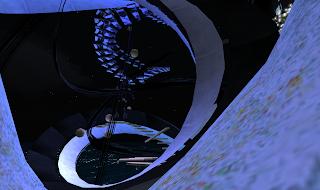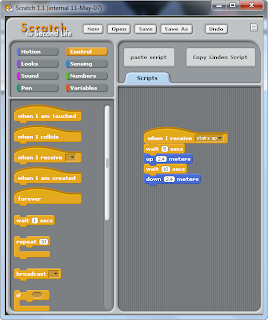Form
The form of our new structure has grown a lot more complex and intricate. We took the prim shape of the tube and the torus and edited many variables of the shape to twist, taper and bend the shape.
We then repeated the shapes we created and weaved them all together to enclose and create a heavily abstract space to house our architectural journals and blogs.
One feature we tried to accomplish was to have our structure interact with the environment and relate it back to it's context, so specific shapes were manipulated to fit and play with the surrounding mountains and underwater. One prominent example being the main, large spiral, that uses an alpha channeled Mark Rothko painting, that fits in between the two large mountains. This frames a clear entrance for the users to go through as well as bringing the mountains into the design.
Other examples of how we related the design back into environment are the arches that also are embedded into the sides of the mountain and into the seabed, with the various twists and curves mimicking the contours and slopes of the land.
Overall shape
Between the mountains
Lights
Another note was how we observed our structure at different parts of the day and how the light bounces and plays off the various surfaces. For the moment we have just placed lights of a cool, blueish colour palette.
Sunrise
Sunset
Midday
Midnite
Staircase
Another detail we placed in our structure was a set never-ending looping stairs of influenced by the works of
Olafur Eliasson. With the stairs we wished to make the structure be accessible at multiple levels to have interesting views outwards to the vast endless ocean and through the twin peaks towards the other projects.
The stairs also fit in with the overall motif of the project with the various swirls and curves, as well as sticking with the monochromatic colour scheme.
Olafur Eliasson - Staircase
Textures
The biggest change to our work however were the application photoshopped textures onto our work. Using the works of famous contemporary painters, such as Jackson Pollock, Franz Kline, and Mark Rothko, we achieved very unique and abstract materiality to our work.
By going through the methods of offsetting the images to then make it seamless across all edges, we also used Alpha Channeling to make select areas of the textures transparent when applied to prims. As we finally applied the textures upon our distorted shapes, it achieved the look of grand, arching paint strokes in the air. As one of my teammates put it, it gave the impression of "painting in the 3rd dimension" and we found it really interesting how that can relate to the architectural process.
Alpha Channeling is the process of using custom made channels in photoshop and brushing in selective areas we wish to make transparent. Using the black brush we can block in areas and make them opaque, while using the white brush we can brush back areas and make them transparent. The strength of the brush can attain various levels of transparency.
The Alpha Channeled texture must then be saved as a TARGA file, (.tga) and with the Alpha Channel box ticked. We then imported the .tga files into Second Life at the cost of 10 Linden dollars and placed them on our prims.
Franz Kline - Alpha Channeled and inverse colours
Franz Kline (American, 1910-1962). Mahoning, 1956. Oil and paper collage on canvas. 80 x 100 in. (203.2 x 254 cm). Purchase, with funds from the Friends of the Whitney Museum of American Art. Whitney Museum of American Art, New York.
Franz Kline - Alpha Channeled
New York, N.Y., oil on canvas by Franz Kline, 1953; in the Albright-Knox Art Gallery, Buffalo, N.Y. 200 ×128 cm.
Mark Rothko - Alpha Channeled
Mark Rothko - Untitled, 1969
Useful Links
Another set of useful links with information for using Second Life. The main Wiki page contains many tutorials and useful content including script languages, taking advantage of certain features of Second Life and so on. However during the development of our structure we wanted to bring over the idea of projection mapping and projecting images onto our building to create a dynamic play between light and shadow.
The article on Deferred Rendering Test as well as the Knowledge Base for Lighting and Shadows explains the points a lot more.
http://wiki.secondlife.com/wiki/Main_Page
http://wiki.secondlife.com/wiki/Deferred_Rendering_Test
http://community.secondlife.com/t5/English-Knowledge-Base/Lighting-and-shadows/ta-p/997819





















































